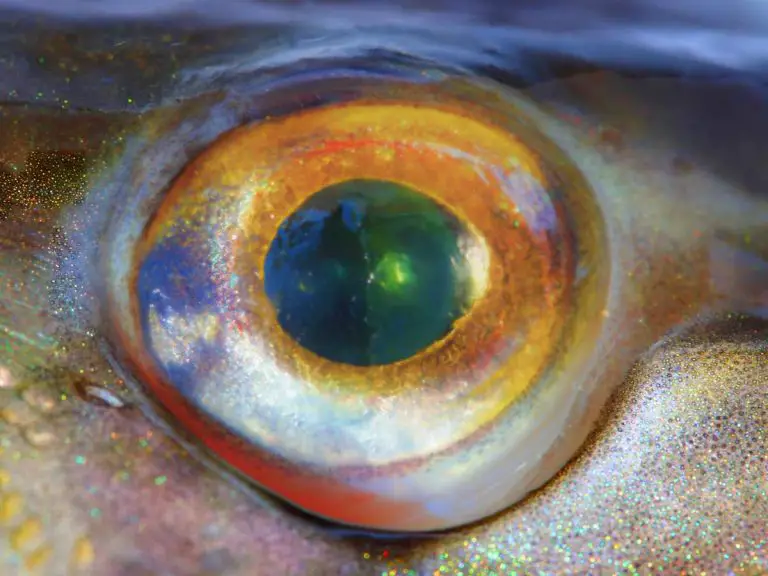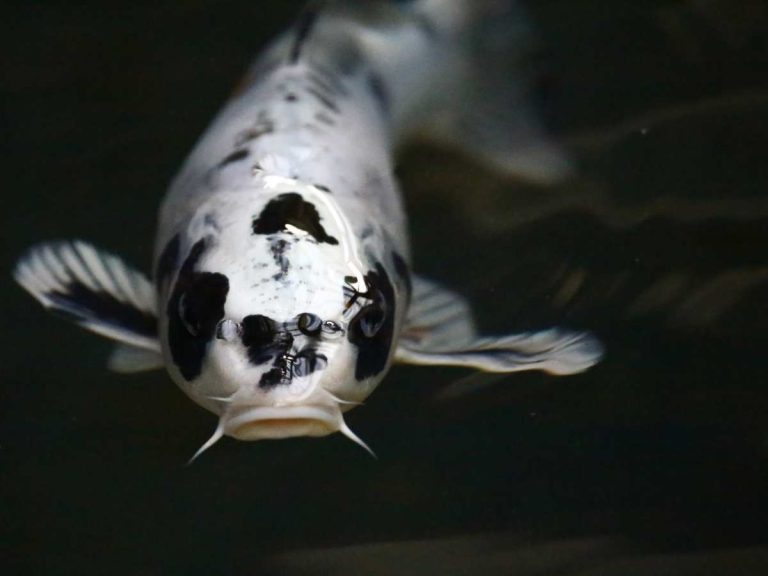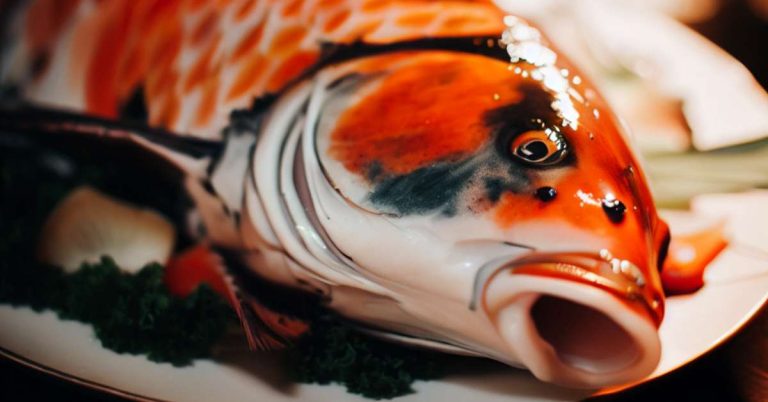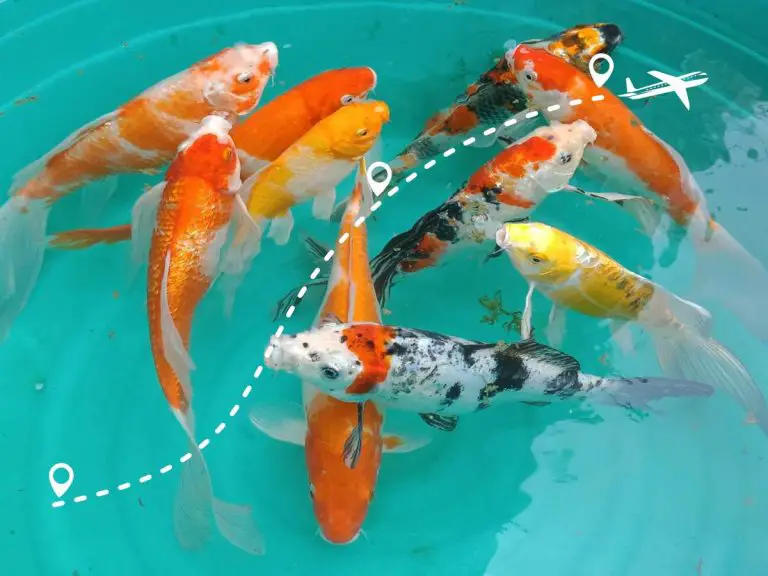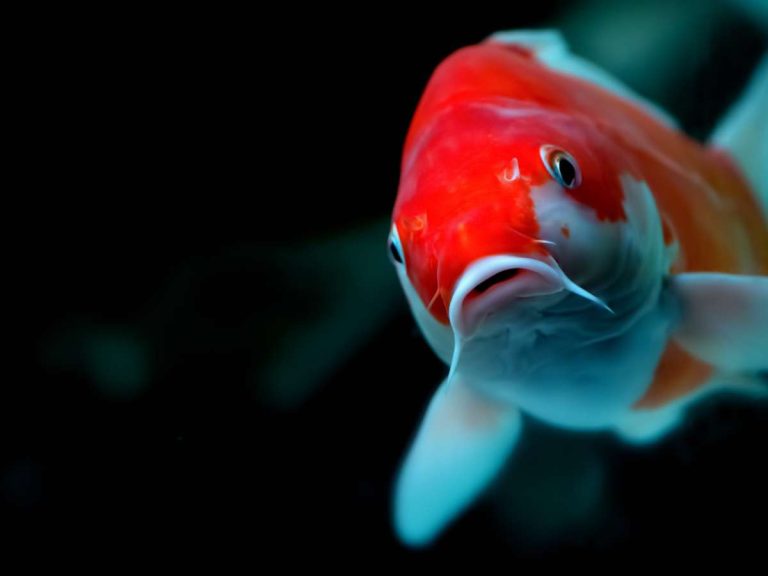Why Is My Koi Losing Color? And How Can I Prevent Further Fading?
Why is my koi losing color? It’s a sad question, and one that many koi fish owners will ask themselves. If your beautiful fish are losing their vibrant hues, fret not! In this article, we’ll explore the possible causes of color loss in koi fish, along with solutions to prevent further fading.
Koi fish can lose their color for various reasons. Factors such as poor water quality, nutritional deficiencies, and stressors in the environment can all contribute to the fading of their vibrant hues. By understanding these causes and taking proactive measures, you can help restore and maintain the stunning colors of your beloved koi.
So, if you’re eager to learn why your koi is losing color and how you can prevent it, keep reading!
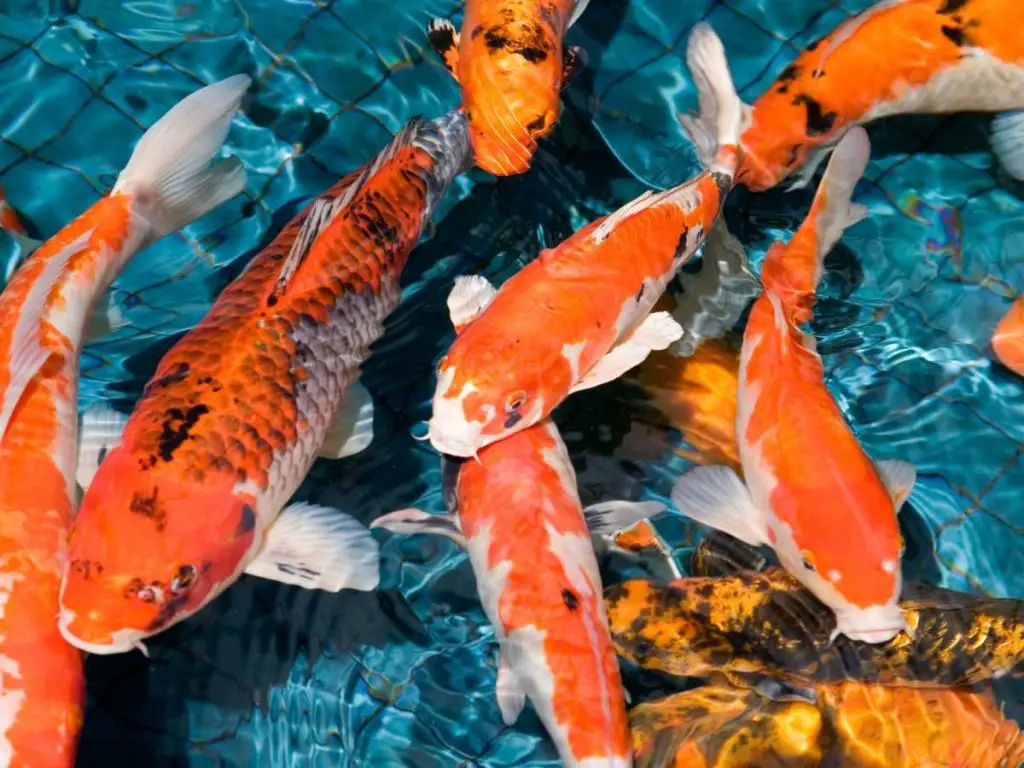
Koi fish coloration
Before we get into why your koi might be losing their color, let’s explore why they’re so vivid in the first place.
Indeed, koi fish are known for their bright and stunning colors, which is why they’re such popular choice among pond enthusiasts. And understanding the intricacies of koi fish coloration can help in maintaining their optimal health and aesthetics.
| Factor | Description |
|---|---|
| Genetics | Koi fish exhibit a wide range of natural color patterns due to genetic factors and breeding. |
| Diet | Essential nutrients like carotenoids, proteins, and fats play a role in maintaining vibrant colors. |
| Environment | The pond environment, including water quality and stressors, can influence the vibrancy of koi fish colors. |
| Health | Bright, vibrant colors indicate the health and well-being of the fish. |
Koi fish exhibit a wide range of natural color patterns, including solid colors, two-tone, and multicolored combinations. These patterns develop as a result of genetic factors and breeding. Each koi fish is unique, with its own distinct coloration and markings.
The color of koi fish plays a significant role in their overall beauty and aesthetics. Bright, vibrant colors are highly desirable and indicate the health and well-being of the fish.
Colors such as red, orange, yellow, and white in particular tend to be more eye-catching and sought after by pond enthusiasts.
Why do koi fish lose their color? Three factors
If your prized koi fish are losing color, there could be several contributing factors at play. Poor water quality, nutritional deficiencies, and stress from environmental factors are commonly associated with a fading or dull appearance in koi fish.
1. Poor water quality
Water quality plays a vital role in maintaining vibrant color in koi fish. Various parameters, such as pH level, ammonia, nitrite, and nitrate levels, can directly impact their coloration.
For example, if the pH level is too high or low, it can affect the way pigments are displayed, resulting in less vibrant colors.
Similarly, high levels of ammonia, nitrite, or nitrate can lead to stress and ultimately contribute to color loss.
2. Nutritional deficiencies
An imbalanced diet can also have a significant impact on the coloration of your koi fish. Essential nutrients, such as carotenoids, proteins, and fats, play a crucial role in maintaining vibrant colors. A lack of these nutrients can result in pale or faded colors in your koi.
To ensure your koi fish maintain their brilliant colors, be sure to provide them with a balanced diet that includes high-quality koi food specifically formulated to enhance color.
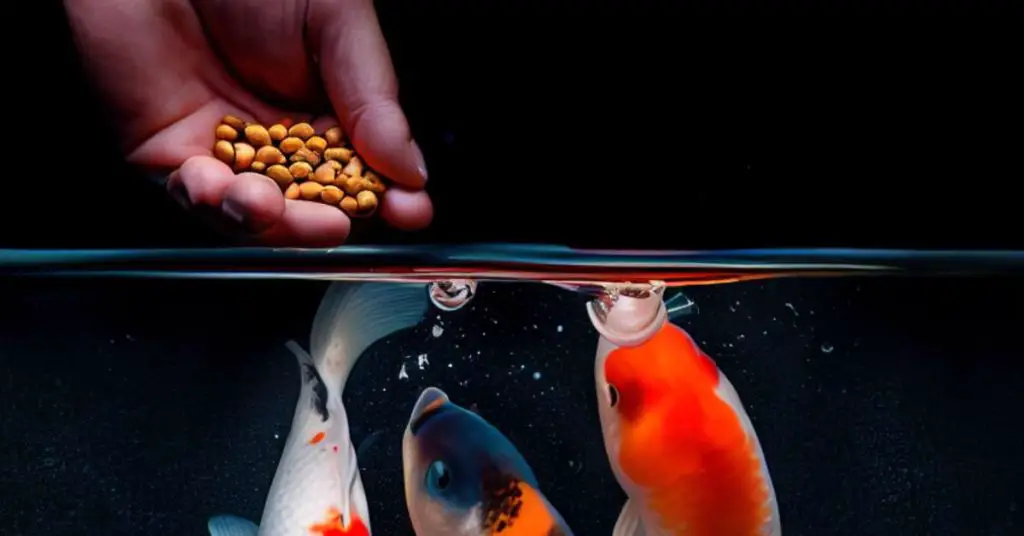
3. Stress and environmental factors
Finally, Stress can be a major cause of color loss in koi fish. When koi fish are stressed, their bodies produce cortisol, a hormone that can affect their overall health, including their coloration. Additionally, various environmental factors can contribute to stress and color loss in koi fish. For example, fluctuations in temperature, inadequate oxygen levels, overcrowding, or exposure to harsh sunlight can all lead to stress and a loss of color.
It is important to be aware of potential stressors and provide a suitable environment for your koi fish to thrive. By minimizing stress in your koi and optimizing the pond environment, you can help maintain and enhance the natural colors of your koi fish.
Ultimately, providing optimal conditions for your koi fish is crucial to prevent color loss and maintain their vibrant hues. By addressing poor water quality, ensuring a balanced diet, and minimizing stress, you can help your koi fish maintain their natural beauty for years to come.
| Cause | Description | Preventative Measures |
|---|---|---|
| Poor Water Quality | Parameters like pH level, ammonia, nitrite, and nitrate levels can impact coloration. | Regularly test and adjust water parameters. Invest in a reliable filtration system. |
| Nutritional Deficiencies | An imbalanced diet can lead to pale or faded colors. | Provide a balanced diet with high-quality koi food formulated for color enhancement. |
| Stress & Environmental Factors | Factors like temperature fluctuations, inadequate oxygen, overcrowding, or harsh sunlight can lead to stress and color loss. | Create a calm habitat with sheltered areas, monitor temperature, and provide sufficient oxygen levels. |
Diagnosing why your koi are losing color
Diagnosing the cause of color loss in your koi fish is crucial in order to implement the appropriate solutions and prevent further fading. There are a few techniques and resources you can utilize to get a better understanding of the underlying issues.
Start by closely observing your koi fish in their pond. Look for any visible signs of distress, such as changes in behavior, decreased appetite, or physical abnormalities. Take note of any specific areas on their body where color loss seems most prominent.
Additionally, carefully examine the water quality in your pond. Pay attention to any unusual smells, cloudiness, or discoloration. Test the water regularly for parameters like pH, ammonia, nitrites, and nitrates. Keep a logbook of these measurements to track any trends or changes.
Finally, if you’re still unsure about the cause of your koi fish’s color loss, it may be beneficial to seek professional advice from a veterinarian who specializes in fish or a knowledgeable koi expert. They can perform a thorough examination of your fish and assess the overall health of your pond.
A veterinarian or koi expert can also conduct tests on the water quality in your pond to determine if any specific issues are contributing to the color loss. They have the expertise to identify potential diseases, nutritional deficiencies, or environmental stressors that might be affecting your koi fish.
Remember, diagnosing the cause of color loss is the first step towards restoring and maintaining vibrant color in your koi fish. Don’t hesitate to seek assistance from professionals who can provide expert guidance in resolving the issue.
Solutions for preventing further color loss
When it comes to preventing further color loss in your beloved koi fish, there are a few key steps you can take to ensure their vibrant hues stay intact. Let’s dive right in!
Step One: Maintain optimal water conditions
One of the main culprits behind color fading in koi fish is poor water quality. To combat this, it’s crucial to regularly test and maintain the water conditions in your pond.
Invest in a reliable water quality testing kit to monitor parameters such as pH, ammonia, nitrite, and nitrate levels. These can have a direct impact on your koi fish’s coloration. Aim for a pH level between 6.8 and 7.2, ammonia and nitrite levels of zero, and nitrate levels below 50 ppm.
In addition to regular testing, make sure you have a suitable filtration system in place. Filters help to remove harmful substances and maintain a clean and healthy environment for your koi fish. Consider options such as biological, mechanical, and UV filters for optimal results.
Step Two: Maintain a balanced and nutritious diet
Another key factor in enhancing and preserving the coloration of your koi fish lies in their diet. Just like us, koi fish need a well-balanced and nutritious diet to maintain their vibrant hues.
Ensure your koi fish are receiving a high-quality koi fish food that contains essential nutrients for color enhancement. Look for foods that are rich in carotenoids, such as spirulina, astaxanthin, and paprika. These compounds contribute to the striking reds, oranges, and yellows in koi fish.
Remember to feed your koi fish small and frequent meals throughout the day, rather than one large meal. This allows for better digestion and absorption of nutrients.
Step Three: Minimize stress and optimizing the pond environment
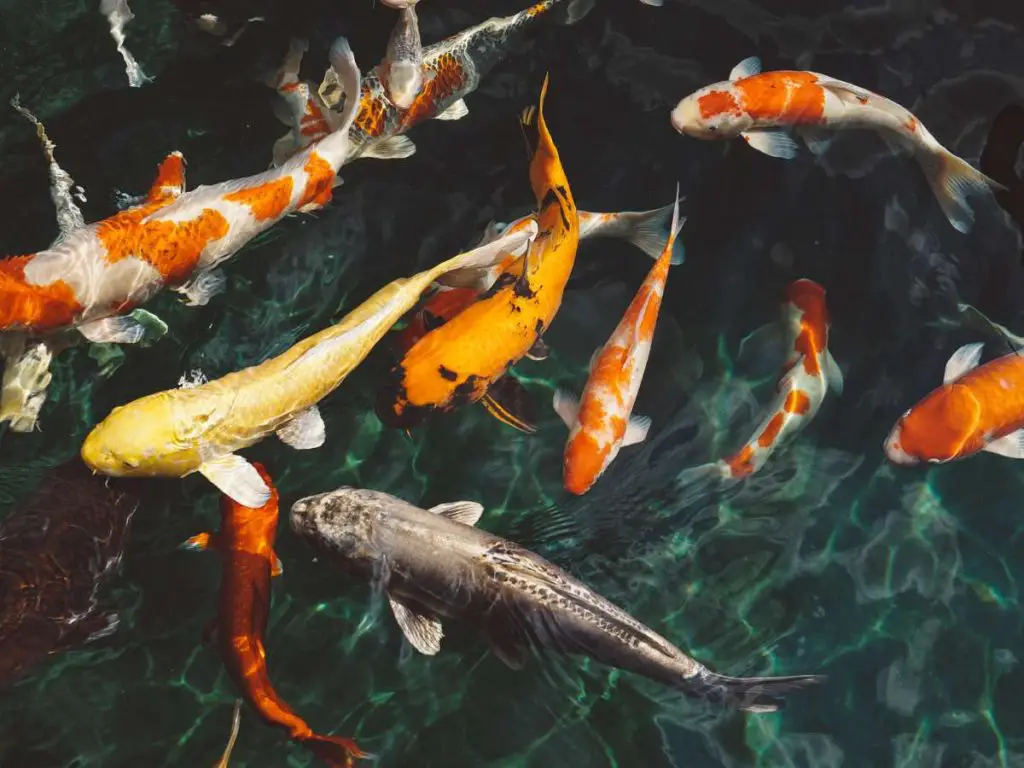
Koi fish, just like any living creature, can experience stress, which can result in color loss. To minimize stress levels in your koi fish, it’s important to create a calm and suitable habitat for them.
Consider providing sheltered areas with rocks, plants, or even a dedicated koi cave where they can retreat and feel secure. This will help reduce stress caused by predators or excessive sunlight.
Additionally, be mindful of potential stressors such as temperature fluctuations, inadequate oxygen levels, or overcrowding. Regularly monitor the temperature of your pond and provide aeration to maintain sufficient oxygen levels for your koi fish.
By taking these steps to maintain optimal water conditions, providing a balanced diet, and reducing stress in their environment, you’ll be well on your way to preventing further color loss in your beautiful koi fish!
How can I improve my koi color
Thankfully, even if the color of your koi fish has started to fade, all is not lost!
One of the first things to remember when it comes to restoring color in koi fish is that nature often has a way of healing itself over time. Just like how our bodies can recover from illnesses and injuries, koi fish have the remarkable ability to regain their vibrant hues naturally.
However, this process requires patience and providing the right conditions for their well-being going forward
Meanwhile, while natural color restoration is effective, there are also additional methods you can use to help enhance and bring back the vibrancy in your koi fish.
One option is to introduce color-enhancing additives into their diet. These products are specifically designed to promote and intensify the natural colors of your koi.
Look for additives that contain high levels of carotenoids, as these are known to enhance reds, oranges, and yellows.
Be sure to follow the recommended dosage and frequency as excessive use may have negative consequences.
What to feed koi for color?
Here are some popular color-enhancing additives and the benefits they offer:
- Spirulina: This natural blue-green algae is rich in pigments that can enhance blue and green hues in your koi fish. It also provides nutritional benefits and supports overall health.
- Astaxanthin: Known for its potent antioxidant properties, astaxanthin promotes the development of vibrant reds and intensifies the colors of your koi. It also supports immune system function.
- Paprika: Yes, you read that right! Paprika contains high levels of red pigments that can help intensify reds and oranges in your koi fish. Just be sure to use a paprika additive specifically formulated for koi ponds.
- Marigold Extract: Marigold flowers contain carotenoids that enhance yellows and oranges. Using a marigold extract additive can help bring out the warm tones in your koi fish.
These additives should be used as supplements to a balanced and nutritious diet, not as a substitute. Remember, restoring color in koi fish is a gradual process, and consistency is key. Monitor your fish closely for any signs of improvement, but be patient as it can take weeks or even months to see significant changes.
| Additive | Description | Benefits |
|---|---|---|
| Spirulina | Natural blue-green algae | Enhances blue and green hues; Provides nutritional benefits; Supports overall health |
| Astaxanthin | Potent antioxidant | Promotes vibrant reds; Intensifies colors; Supports immune system function |
| Paprika | Red spice | Intensifies reds and oranges (use koi-specific additive) |
| Marigold Extract | Extract from marigold flowers | Enhances yellows and oranges |
Monitoring and maintaining vibrant koi fish color
Keeping a close eye on your koi fish is essential for maintaining vibrant coloration. Set aside some time each day to observe their behavior and appearance (watching your beautiful fish daily is why you got them, right?). When you do, look for any noticeable changes in color, such as fading or blotchiness. Take note of any other physical signs, like changes in appetite, behavior, or gill health.
But color alone isn’t always an accurate indicator of health. Keep in mind that koi fish naturally change color throughout their lifespan, so some variation is normal. Nonetheless, significant and rapid color loss is cause for concern and should be addressed as soon as possible.
Always troubleshoot potential color loss issues
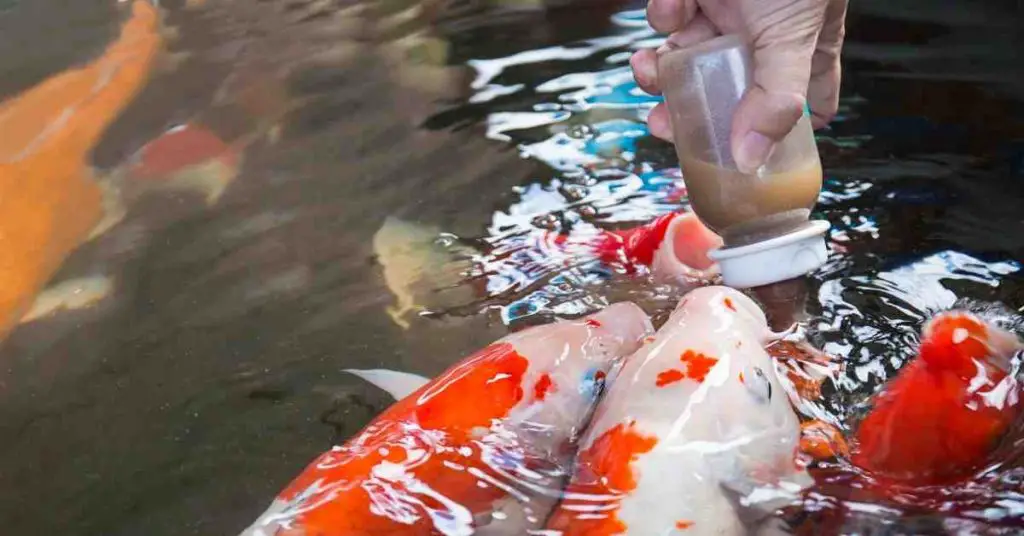
If you notice a decline in your koi fish’s color, it’s time to play detective and troubleshoot the potential causes. Start by evaluating the water quality parameters to ensure they are within the optimal range. Check the levels of ammonia, nitrite, nitrate, pH, and temperature. A reference table listing these parameters and their desired values can help you determine if your water quality is up to par.
Next, critically assess their diet and nutrition. Are they receiving a balanced and varied diet? Take note of any nutritional deficiencies that might be causing their color loss. Consider consulting with a veterinarian or koi expert to get professional advice on adjusting their diet and supplementing any missing nutrients.
Lastly, examine the pond environment and potential stressors that may be affecting your koi fish. Are there any external factors like predators, excessive noise, or poor water circulation? Addressing these stressors and providing a calm and suitable habitat for your koi fish can go a long way in restoring their color and overall well-being.
Let Your Koi Shine Bright!
So, there you have it – a comprehensive exploration of why your beloved koi fish may be losing their vibrant colors. We’ve discussed the importance of color in koi fish aesthetics and delved into the various factors that can contribute to color loss, such as poor water quality, nutritional deficiencies, and stress.
To prevent further fading, it’s crucial to maintain optimal water conditions by regularly testing and maintaining water quality and investing in suitable filtration systems. Additionally, providing a balanced and nutritious diet is essential in keeping your koi fish’s colors vibrant and beautiful. Lastly, it’s important to reduce stress and create a suitable habitat for your fish to thrive.
If you do notice your koi fish losing their color, don’t panic! Natural color restoration can occur over time, but you may also consider using color-enhancing additives or techniques to help bring back their vibrant hues.
In summary, here are the main facts covered in this article:
- Natural color patterns and variations in koi fish
- Common causes of color loss, including poor water quality, nutritional deficiencies, and stress
- Methods for diagnosing the cause of color loss
- Solutions for preventing further color loss, including maintaining optimal water conditions, providing a balanced diet, and reducing stress
- Options for restoring color in koi fish, including natural restoration and using color-enhancing additives
- Tips for monitoring and maintaining vibrant koi fish color
Remember, keeping your koi fish’s colors vibrant not only adds beauty to your pond but also indicates their overall health and well-being. So, follow the solutions provided and consider consulting professionals if needed. Your colorful koi fish will thank you for it!
Related Questions
Why are some of my koi fish losing color while others remain vibrant?
Koi fish can have different coloration genetics, and their individual genetics play a significant role in their color intensity and patterns. Some koi may naturally have more vibrant colors than others, so it’s normal to see variations in coloration within a group of koi. Additionally, factors such as age, health, and environmental conditions can also contribute to differences in coloration among koi fish in the same pond.
Can stress really cause koi fish to lose their color?
Yes, stress can indeed lead to color loss in koi fish. When koi are stressed, their natural color can fade or become dull. Stressors such as poor water quality, overcrowding, sudden changes in temperature, and inadequate nutrition can all contribute to color fading in koi. It’s important to minimize stress in your koi pond to help maintain the vibrant color of your fish.


